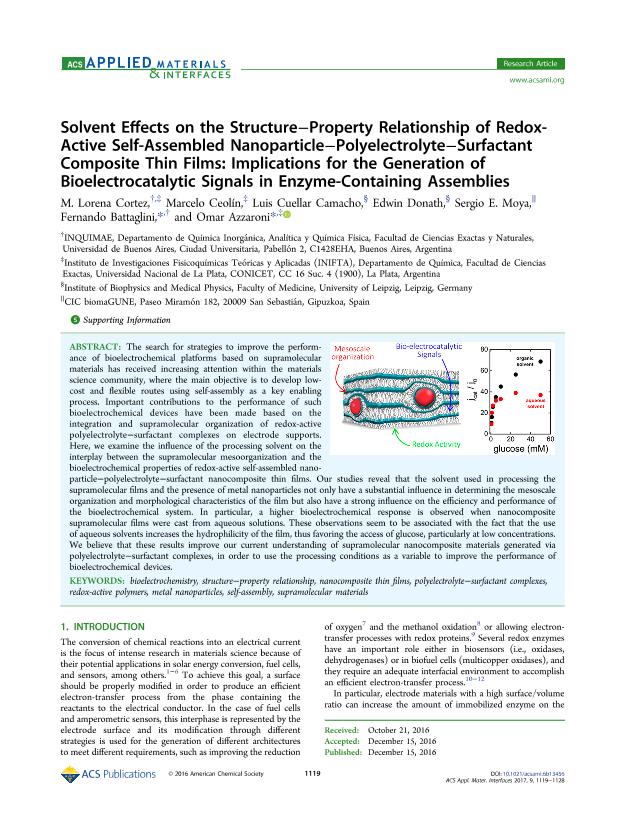Mostrar el registro sencillo del ítem
dc.contributor.author
Cortez, María Lorena

dc.contributor.author
Ceolin, Marcelo Raul

dc.contributor.author
Camacho, Luis Cuellar
dc.contributor.author
Donath, Edwin
dc.contributor.author
Moya, Sergio Eduardo

dc.contributor.author
Battaglini, Fernando

dc.contributor.author
Azzaroni, Omar

dc.date.available
2018-11-09T18:03:32Z
dc.date.issued
2017-01
dc.identifier.citation
Cortez, María Lorena; Ceolin, Marcelo Raul; Camacho, Luis Cuellar; Donath, Edwin; Moya, Sergio Eduardo; et al.; Solvent effects on the structure-property relationship of redox-Active self-Assembled nanoparticle-polyelectrolyte-surfactant composite thin films: Implications for the generation of bioelectrocatalytic signals in enzyme-containing assemblies; American Chemical Society; ACS Applied Materials & Interfaces; 9; 1; 1-2017; 1119-1128
dc.identifier.issn
1944-8244
dc.identifier.uri
http://hdl.handle.net/11336/64103
dc.description.abstract
The search for strategies to improve the performance of bioelectrochemical platforms based on supramolecular materials has received increasing attention within the materials science community, where the main objective is to develop lowcost and flexible routes using self-Assembly as a key enabling process. Important contributions to the performance of such bioelectrochemical devices have been made based on the integration and supramolecular organization of redox-Active polyelectrolyte-surfactant complexes on electrode supports. Here, we examine the influence of the processing solvent on the interplay between the supramolecular mesoorganization and the bioelectrochemical properties of redox-Active self-Assembled nanoparticle- polyelectrolyte-surfactant nanocomposite thin films. Our studies reveal that the solvent used in processing the supramolecular films and the presence of metal nanoparticles not only have a substantial influence in determining the mesoscale organization and morphological characteristics of the film but also have a strong influence on the efficiency and performance of the bioelectrochemical system. In particular, a higher bioelectrochemical response is observed when nanocomposite supramolecular films were cast from aqueous solutions. These observations seem to be associated with the fact that the use of aqueous solvents increases the hydrophilicity of the film, thus favoring the access of glucose, particularly at low concentrations. We believe that these results improve our current understanding of supramolecular nanocomposite materials generated via polyelectrolyte-surfactant complexes, in order to use the processing conditions as a variable to improve the performance of bioelectrochemical devices.
dc.format
application/pdf
dc.language.iso
eng
dc.publisher
American Chemical Society

dc.rights
info:eu-repo/semantics/openAccess
dc.rights.uri
https://creativecommons.org/licenses/by-nc-sa/2.5/ar/
dc.subject
Bioelectrochemistry
dc.subject
Metal Nanoparticles
dc.subject
Nanocomposite Thin Films
dc.subject
Polyelectrolyte-Surfactant Complexes
dc.subject
Redox-Active Polymers
dc.subject
Self-Assembly
dc.subject
Structure-Property Relationship
dc.subject
Supramolecular Materials
dc.subject.classification
Otras Ciencias Químicas

dc.subject.classification
Ciencias Químicas

dc.subject.classification
CIENCIAS NATURALES Y EXACTAS

dc.title
Solvent effects on the structure-property relationship of redox-Active self-Assembled nanoparticle-polyelectrolyte-surfactant composite thin films: Implications for the generation of bioelectrocatalytic signals in enzyme-containing assemblies
dc.type
info:eu-repo/semantics/article
dc.type
info:ar-repo/semantics/artículo
dc.type
info:eu-repo/semantics/publishedVersion
dc.date.updated
2018-10-22T22:31:20Z
dc.journal.volume
9
dc.journal.number
1
dc.journal.pagination
1119-1128
dc.journal.pais
Estados Unidos

dc.journal.ciudad
Washington
dc.description.fil
Fil: Cortez, María Lorena. Consejo Nacional de Investigaciones Científicas y Técnicas. Oficina de Coordinación Administrativa Ciudad Universitaria. Instituto de Química, Física de los Materiales, Medioambiente y Energía. Universidad de Buenos Aires. Facultad de Ciencias Exactas y Naturales. Instituto de Química, Física de los Materiales, Medioambiente y Energía; Argentina. Consejo Nacional de Investigaciones Científicas y Técnicas. Centro Científico Tecnológico Conicet - La Plata. Instituto de Investigaciones Fisicoquímicas Teóricas y Aplicadas. Universidad Nacional de La Plata. Facultad de Ciencias Exactas. Instituto de Investigaciones Fisicoquímicas Teóricas y Aplicadas; Argentina
dc.description.fil
Fil: Ceolin, Marcelo Raul. Consejo Nacional de Investigaciones Científicas y Técnicas. Centro Científico Tecnológico Conicet - La Plata. Instituto de Investigaciones Fisicoquímicas Teóricas y Aplicadas. Universidad Nacional de La Plata. Facultad de Ciencias Exactas. Instituto de Investigaciones Fisicoquímicas Teóricas y Aplicadas; Argentina
dc.description.fil
Fil: Camacho, Luis Cuellar. University of Leipzig; Alemania
dc.description.fil
Fil: Donath, Edwin. University of Leipzig; Alemania
dc.description.fil
Fil: Moya, Sergio Eduardo. Consejo Nacional de Investigaciones Científicas y Técnicas; Argentina. CIC biomaGUNE; España
dc.description.fil
Fil: Battaglini, Fernando. Consejo Nacional de Investigaciones Científicas y Técnicas. Oficina de Coordinación Administrativa Ciudad Universitaria. Instituto de Química, Física de los Materiales, Medioambiente y Energía. Universidad de Buenos Aires. Facultad de Ciencias Exactas y Naturales. Instituto de Química, Física de los Materiales, Medioambiente y Energía; Argentina
dc.description.fil
Fil: Azzaroni, Omar. Consejo Nacional de Investigaciones Científicas y Técnicas. Centro Científico Tecnológico Conicet - La Plata. Instituto de Investigaciones Fisicoquímicas Teóricas y Aplicadas. Universidad Nacional de La Plata. Facultad de Ciencias Exactas. Instituto de Investigaciones Fisicoquímicas Teóricas y Aplicadas; Argentina
dc.journal.title
ACS Applied Materials & Interfaces

dc.relation.alternativeid
info:eu-repo/semantics/altIdentifier/url/https://pubs.acs.org/doi/10.1021/acsami.6b13456
dc.relation.alternativeid
info:eu-repo/semantics/altIdentifier/doi/https://dx.doi.org/10.1021/acsami.6b13456
Archivos asociados
